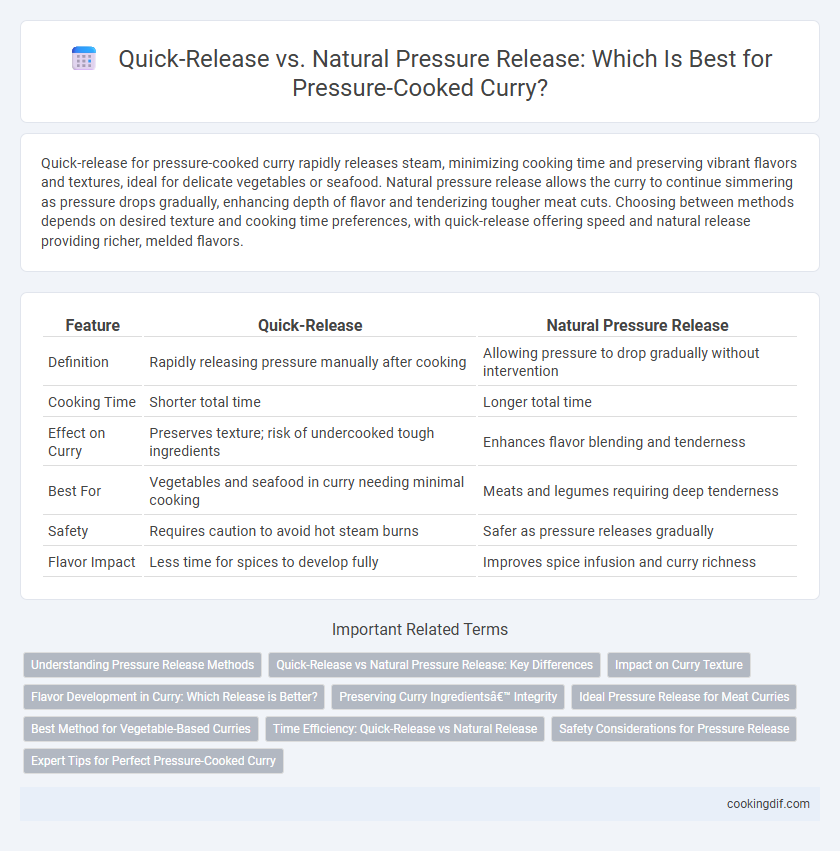Quick-release for pressure-cooked curry rapidly releases steam, minimizing cooking time and preserving vibrant flavors and textures, ideal for delicate vegetables or seafood. Natural pressure release allows the curry to continue simmering as pressure drops gradually, enhancing depth of flavor and tenderizing tougher meat cuts. Choosing between methods depends on desired texture and cooking time preferences, with quick-release offering speed and natural release providing richer, melded flavors.
Table of Comparison
| Feature | Quick-Release | Natural Pressure Release |
|---|---|---|
| Definition | Rapidly releasing pressure manually after cooking | Allowing pressure to drop gradually without intervention |
| Cooking Time | Shorter total time | Longer total time |
| Effect on Curry | Preserves texture; risk of undercooked tough ingredients | Enhances flavor blending and tenderness |
| Best For | Vegetables and seafood in curry needing minimal cooking | Meats and legumes requiring deep tenderness |
| Safety | Requires caution to avoid hot steam burns | Safer as pressure releases gradually |
| Flavor Impact | Less time for spices to develop fully | Improves spice infusion and curry richness |
Understanding Pressure Release Methods
Quick-release method rapidly vents steam from the pressure cooker, preserving the texture of delicate curry ingredients like vegetables and seafood, while minimizing overcooking. Natural pressure release allows the pressure to drop gradually, ideal for developing deeper flavors and tenderizing tougher cuts of meat in curries. Choosing the appropriate pressure release technique enhances the overall taste and consistency of pressure-cooked curry dishes.
Quick-Release vs Natural Pressure Release: Key Differences
Quick-release rapidly lowers the pressure in a pressure cooker by manually venting steam, which stops the cooking process immediately and prevents overcooking, ideal for delicate ingredients in curry such as vegetables and seafood. Natural pressure release allows the pressure to gradually decrease on its own, promoting deeper flavor development and tenderizing tougher ingredients like meat or legumes in curries. Choosing between quick-release and natural pressure release depends on the desired texture and cooking time, with quick-release preserving freshness and natural release enhancing richness.
Impact on Curry Texture
Quick-release of pressure in cooking curry results in a firmer, chunkier texture as the abrupt depressurization stops further softening of ingredients. Natural pressure release allows the curry to continue cooking gently under residual heat, producing a richer, thicker sauce and more tender meat or vegetables. Choosing between these methods impacts the final mouthfeel, with quick-release favoring firmer textures and natural release enhancing softness and flavor integration.
Flavor Development in Curry: Which Release is Better?
Natural pressure release enhances curry flavor development by allowing continued simmering, which deepens the complexity and richness of spices and ingredients. Quick-release halts cooking immediately, preserving fresh, vibrant notes but limiting the melding of flavors typical in slow-cooked curries. For robust, well-integrated taste profiles, natural pressure release is generally preferred in pressure-cooked curry preparation.
Preserving Curry Ingredients’ Integrity
Quick-release pressure cooking rapidly depressurizes the pot, which can prevent overcooking delicate curry ingredients like vegetables and herbs, preserving their texture and vibrant flavor. Natural pressure release allows gradual pressure reduction, resulting in more tender meat but may cause some vegetables to become mushy and lose integrity. Choosing between quick-release and natural release depends on the specific curry recipe and desired ingredient texture, with quick-release favored for preserving the freshness of delicate components.
Ideal Pressure Release for Meat Curries
Ideal pressure release for meat curries involves combining quick-release and natural pressure release methods to preserve tenderness and enhance flavor. Natural pressure release allows the meat fibers to relax gently, preventing toughness and ensuring a succulent texture. Using a brief quick-release after natural pressure release helps to safely reduce residual pressure without overcooking the curry.
Best Method for Vegetable-Based Curries
For vegetable-based curries, natural pressure release preserves texture and prevents overcooking delicate ingredients like spinach or peas. Quick-release can cause abrupt changes in pressure, leading to mushy or unevenly cooked vegetables. Using natural pressure release enhances flavor absorption and maintains vibrant colors in the curry.
Time Efficiency: Quick-Release vs Natural Release
Quick-release method expedites curry cooking by rapidly releasing steam, cutting total time significantly compared to natural pressure release, which allows gradual depressurization and better flavor integration but requires 10-20 minutes longer. Time efficiency is crucial when preparing curry on busy schedules, making quick-release the preferred choice for immediate meal service. However, natural release retains more moisture and tenderness in the curry, benefiting recipes that prioritize texture over speed.
Safety Considerations for Pressure Release
Quick-release method rapidly vents steam, reducing cooking time but requires careful handling to avoid burns from hot steam and splattering curry. Natural pressure release allows pressure to drop gradually, minimizing risk of sudden steam bursts and ensuring safer handling after cooking. Always follow manufacturer guidelines and use protective gear like oven mitts to prevent injury during either pressure release method.
Expert Tips for Perfect Pressure-Cooked Curry
Quick-release method rapidly reduces pressure, preserving the vibrant flavors and tender texture of curry ingredients, ideal for delicate vegetables and seafood. Natural pressure release allows gradual cooling, enabling spices and meats to deepen in flavor and become melt-in-your-mouth tender, perfect for robust, slow-simmered curries. Expert chefs recommend blending both techniques: quick-release to prevent overcooking vegetables and natural release to enhance meat-based curry richness.
Quick-release vs natural pressure release for pressure-cooked curry Infographic

 cookingdif.com
cookingdif.com